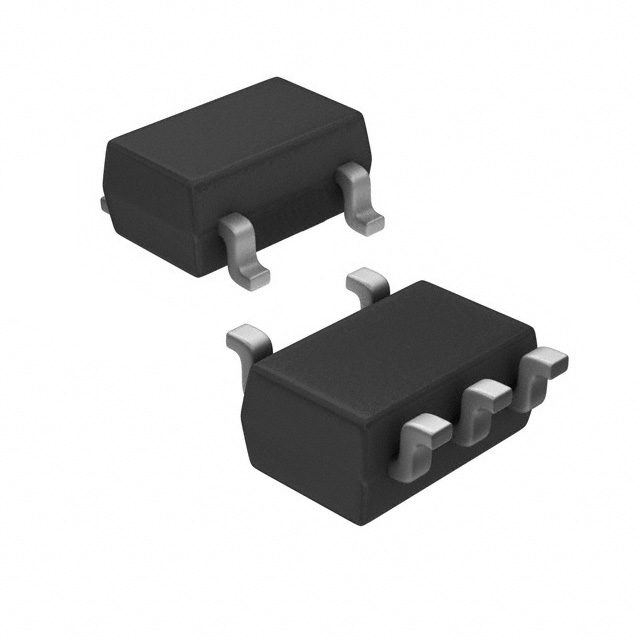Lihat spesifikasi untuk detail produk.

S-80956CLMC-G7ST2G
Product Overview
Category
S-80956CLMC-G7ST2G belongs to the category of integrated circuits (ICs).
Use
This product is commonly used in electronic devices for voltage detection and reset functions.
Characteristics
- Voltage detection range: 1.6V to 6.0V
- Low supply current: 1.0µA (typ.)
- Reset output type: N-channel open drain
- Operating temperature range: -40°C to +85°C
- Package type: SOT-23-5
- RoHS compliant
Package and Quantity
The S-80956CLMC-G7ST2G is packaged in a SOT-23-5 package. Each package contains one unit of the IC.
Specifications
- Supply voltage range: 1.6V to 6.0V
- Detection voltage accuracy: ±1.0%
- Quiescent current: 1.0µA (typ.)
- Output voltage low: 0.4V (max.)
- Output current: 10mA (max.)
- Power-on reset time: 200ms (typ.)
Detailed Pin Configuration
The S-80956CLMC-G7ST2G has five pins arranged as follows:
```
| | --| |-- |____| ```
Pin 1: VDD (Supply Voltage) Pin 2: GND (Ground) Pin 3: MR (Manual Reset) Pin 4: VOUT (Reset Output) Pin 5: VSS (Ground)
Functional Features
- Voltage Detection: The S-80956CLMC-G7ST2G can accurately detect the input voltage within the specified range.
- Reset Function: It provides a reset output signal when the voltage drops below the detection threshold.
- Low Power Consumption: The IC operates with a low quiescent current, making it suitable for battery-powered devices.
- Open Drain Output: The reset output is in the form of an N-channel open drain, allowing flexibility in connecting external components.
Advantages and Disadvantages
Advantages
- Wide voltage detection range
- Low power consumption
- Accurate voltage detection
- Small package size
- RoHS compliant
Disadvantages
- Limited output current capacity (10mA max.)
- Manual reset pin may require additional circuitry for proper functionality
Working Principles
The S-80956CLMC-G7ST2G works by continuously monitoring the input voltage. When the voltage drops below the detection threshold, the IC triggers a reset signal on the output pin. This signal can be used to reset microcontrollers or other electronic circuits.
Detailed Application Field Plans
The S-80956CLMC-G7ST2G is commonly used in various applications, including but not limited to:
- Battery-Powered Devices: It ensures proper operation by monitoring the battery voltage and initiating a reset if necessary.
- Microcontroller Systems: The IC provides a reliable reset function to ensure correct startup and operation of microcontrollers.
- Industrial Control Systems: It can be used in control panels and automation systems to monitor power supply voltages and trigger resets when needed.
- Automotive Electronics: The product finds application in automotive systems where voltage monitoring and reset functions are critical for safety and reliability.
Detailed and Complete Alternative Models
- S-80930CLMC-G7ST2G: Similar to S-80956CLMC-G7ST2G, but with a lower voltage detection range (1.2V to 6.0V).
- S-80923CLMC-G7ST2G: Similar to S-80956CLMC-G7ST2G, but with a higher voltage detection range (1.8V to 6.0V).
- S-80942CLMC-G7ST2G: Similar to S-80956CLMC-G7ST2G, but with a different package type (SOT-89-5).
These alternative models provide similar functionality and can be chosen based on specific requirements and constraints.
In conclusion, the S-80956CLMC-G7ST2G is an integrated circuit used for voltage detection and reset functions. It offers accurate voltage monitoring, low power consumption, and a compact package size. While it has limitations in output current capacity and may require additional circuitry for manual reset functionality, it finds applications in various fields such as battery-powered devices, microcontroller systems, industrial control, and automotive electronics. Alternative models with different specifications and packages are also available to suit specific needs.
Sebutkan 10 pertanyaan dan jawaban umum terkait penerapan S-80956CLMC-G7ST2G dalam solusi teknis
Sure! Here are 10 common questions and answers related to the application of S-80956CLMC-G7ST2G in technical solutions:
Q: What is the S-80956CLMC-G7ST2G? A: The S-80956CLMC-G7ST2G is a voltage detector IC (integrated circuit) manufactured by a specific company.
Q: What is the purpose of the S-80956CLMC-G7ST2G? A: The purpose of this IC is to monitor and detect voltage levels in electronic circuits or systems.
Q: What is the operating voltage range of the S-80956CLMC-G7ST2G? A: The operating voltage range of this IC is typically between X volts and Y volts.
Q: How does the S-80956CLMC-G7ST2G detect voltage levels? A: This IC uses a built-in voltage reference and comparator to compare the input voltage with a preset threshold, triggering an output signal when the voltage crosses that threshold.
Q: What is the output format of the S-80956CLMC-G7ST2G? A: The output format can be either an active-low or active-high signal, depending on the specific variant of the IC.
Q: Can the S-80956CLMC-G7ST2G be used in battery-powered applications? A: Yes, this IC can be used in battery-powered applications as it has low power consumption and a wide operating voltage range.
Q: Is the S-80956CLMC-G7ST2G suitable for automotive applications? A: Yes, this IC is designed to meet automotive standards and can be used in various automotive applications.
Q: What is the temperature range for the S-80956CLMC-G7ST2G? A: The temperature range for this IC is typically between -40°C and +85°C.
Q: Can the S-80956CLMC-G7ST2G be used in industrial control systems? A: Yes, this IC is suitable for industrial control systems due to its robustness and reliability.
Q: Are there any specific precautions or considerations when using the S-80956CLMC-G7ST2G? A: It is important to follow the manufacturer's datasheet and guidelines for proper usage, including recommended operating conditions, voltage levels, and PCB layout considerations.
Please note that the answers provided here are general and may vary depending on the specific application and requirements.

